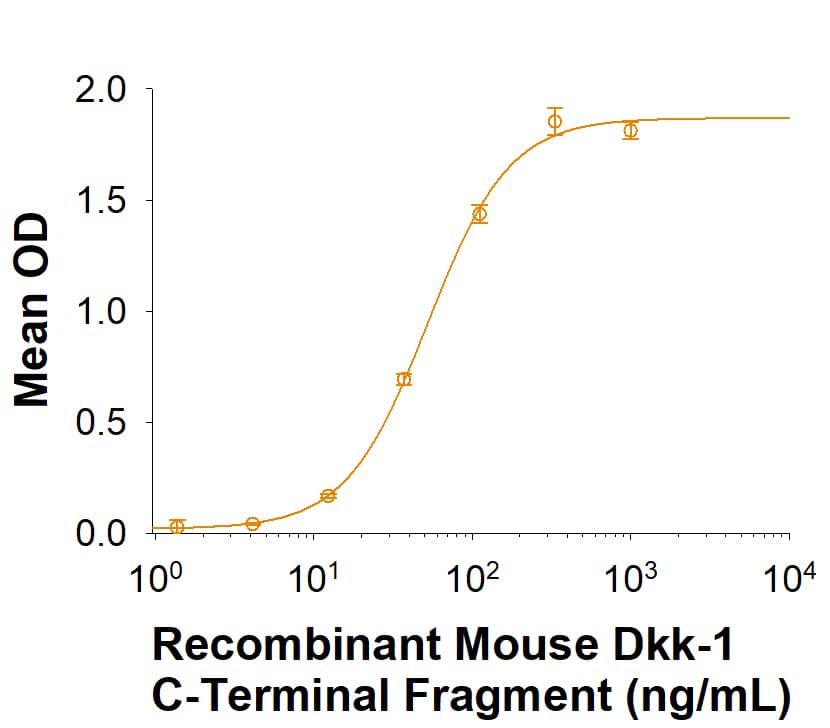Recombinant Mouse Dkk-1 C-Terminal Fragment Protein, CF
R&D Systems, part of Bio-Techne | Catalog # 9838-DK

Key Product Details
Product Specifications
Source
Chinese Hamster Ovary cell line, CHO-derived mouse Dkk-1 protein
Asp145-His272, with an N-terminal 6-His tag
Asp145-His272, with an N-terminal 6-His tag
Purity
>95%, by SDS-PAGE visualized with Silver Staining and quantitative densitometry by Coomassie® Blue Staining.
Endotoxin Level
<0.10 EU per 1 μg of the protein by the LAL method.
N-terminal Sequence Analysis
His
Predicted Molecular Mass
15 kDa
SDS-PAGE
19-38 kDa, reducing conditions
Activity
Measured by its binding ability in a functional ELISA.
When Recombinant Mouse LRP-6 (C-Terminal Fragment) Fc Chimera is immobilized onto a Goat anti-human IgG Fc coated plate, Recombinant Mouse Dkk‑1 C-Terminal Fragment binds with an ED50 of 30-240 ng/mL.
When Recombinant Mouse LRP-6 (C-Terminal Fragment) Fc Chimera is immobilized onto a Goat anti-human IgG Fc coated plate, Recombinant Mouse Dkk‑1 C-Terminal Fragment binds with an ED50 of 30-240 ng/mL.
Scientific Data Images for Recombinant Mouse Dkk-1 C-Terminal Fragment Protein, CF
Recombinant Mouse Dkk-1 C-Terminal Fragment Protein Binding Activity
When Recombinant Mouse LRP-6 (C-Terminal Fragment) Fc Chimera is immobilized onto a Goat anti-human IgG Fc coated plate, Recombinant Mouse Dkk‑1 C-Terminal Fragment (Catalog # 9838-DK) binds with an ED50 of 30-240 ng/mL.Formulation, Preparation and Storage
9838-DK
| Formulation | Lyophilized from a 0.2 μm filtered solution in PBS. |
| Reconstitution |
Reconstitute at 100 μg/mL in PBS.
|
| Shipping | The product is shipped at ambient temperature. Upon receipt, store it immediately at the temperature recommended below. |
| Stability & Storage |
|
Background: Dkk-1
References
- Glinka, A. et al. (1998) Nature 391:357.
- Niehrs, C. (2006) Oncogene 25:7469.
- Ahn, V.E. et al. (2011) Dev. Cell 21:862.
- Mao, B. et al. (2001) Nature 411:321.
- Brott, B.K. and S.Y. Sokol (2002) Mol. Cell. Biol. 22:6100.
- Kimura, H. et al. (2016) J Clin Invest. 126:7.
- Chen, S. et al. (2011) Dev. Cell 21:848.
- Bourhis, E. et al. (2011) Structure 19:1433.
- Cheng, Z. et al. (2011) Nat. Struct. Mol. Biol. 18:1204.
- Mao, B. et al. (2002) Nature 417:664.
- Semënov, M.V. et al. (2008) J. Biol. Chem. 283:21427.
- Mukhopadhyay, M. et al. (2001) Dev. Cell 1:423.
- MacDonald, B.T. et al. (2007) Bone 41:331.
- MacDonald, B.T. et al. (2004) Development 131:2543.
- Li, J. et al. (2006) Bone 39:754.
- Verani, R. et al. (2007) J. Neurochem. 100:242.
- Cajánek, L. et al. (2009) Stem Cells 27:2917.
- Menezes, M.E. et al. (2012) Int. J. Cancer 130:1477.
Long Name
Dickkopf-1
Alternate Names
Dkk1
Gene Symbol
DKK1
UniProt
Additional Dkk-1 Products
Product Documents for Recombinant Mouse Dkk-1 C-Terminal Fragment Protein, CF
Product Specific Notices for Recombinant Mouse Dkk-1 C-Terminal Fragment Protein, CF
For research use only
